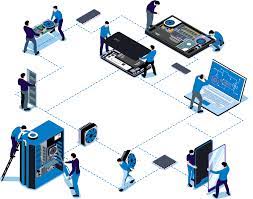In portable power, two heavyweight contenders dominate the conversation: lifepo4 100ah and Lithium-ion (Li-ion) batteries, each with a substantial 100Ah capacity. This blog post embarks on an exploratory journey through the intricacies of these battery types, shedding light on their chemistry, benefits, applications, and environmental impacts alongside emerging trends and the pivotal role of Battery Management Systems (BMS).
Unravelling The Chemistry Behind Lifepo4 & Li-Ion Batteries
LiFePO4 batteries, coupled with a graphite anode, utilize lithium iron phosphate for the cathode material. This combination ensures a stable structure, enhancing safety through its resistance to overheating and lowering the likelihood of thermal runaway. Conversely, Li-ion batteries typically incorporate cathode materials such as lithium cobalt oxide or lithium manganese oxide. These materials contribute to Li-ion batteries’ higher energy density but also introduce a higher propensity for overheating.
The distinction in cathode materials between these two types of batteries affects their energy density and safety profiles and influences their overall performance and suitability for various applications. This fundamental difference in chemistry underscores each battery type’s unique advantages and considerations, setting the stage for a deeper understanding of their respective roles in powering today’s mobile and stationary applications.
Delving Into The 100Ah Capacity: What Does It Mean?
- Understanding the significance of a 100Ah rating is crucial for appreciating the potential of both Lithium Iron Phosphate (LiFePO4) and Lithium-ion (Li-ion) batteries. This metric, denoting ampere-hours, reveals the electrical charge capacity of a battery.
- Simply put, a battery with a 100Ah capacity can supply a current of 100 amperes for an hour or, a current of 10 amperes over 10 hours. This characteristic is particularly important for those applications where sustained power delivery over time is essential.
- Whether it’s powering an electric vehicle, providing backup energy for solar power systems, or running high-demand portable electronics, the 100Ah capacity ensures that these batteries can efficiently meet a wide range of energy requirements.
- It serves as a benchmark for evaluating the endurance of batteries, facilitating comparison across different types and brands, thus enabling users to make informed decisions based on their specific power needs and application scenarios.
Understanding this capacity helps in energy storage and consumption planning, ensuring that devices and systems operate optimally without the risk of premature power depletion.
The Advantages Of 100Ah Lifepo4 Batteries Explained
One of the most notable strengths of 100Ah LiFePO4 batteries lies in their exceptional cycle life. They can endure between 2000 and 5000 charge cycles, making them a reliable power source for extended periods. Their performance remains robust across a wide temperature spectrum, ensuring consistent energy delivery even under varying climatic conditions.

Unlike other battery technologies, LiFePO4 variants exhibit minimal capacity degradation over time, sustaining their efficiency. This durability translates into fewer replacements and a lower total cost of ownership. Safety is another critical advantage; the stable chemistry of LiFePO4 batteries minimises the risk of thermal runaway, a concern in high-demand scenarios.
Exploring The Benefits Of Li Ion Battery 100ah
The hallmark of 100Ah Li-ion batteries is their remarkable energy density, which underpins their suitability for applications where size and weight constraints are critical. This characteristic facilitates a blend of portability and enduring power, making these batteries particularly advantageous for gadgets and devices that are frequently on the move.
They distinguish themselves further through their rapid charging capabilities, an attribute that enhances user convenience by significantly reducing downtime between uses. Additionally, Li-ion batteries are renowned for their low self-discharge rates, which are a boon for ensuring long-term energy retention, especially in scenarios where the batteries may not be in constant use.
This feature ensures that energy is conserved more effectively over periods of inactivity, thereby readying devices for immediate use when needed without necessitating frequent recharges. Such attributes underscore the suitability of li ion battery 100ah for a broad spectrum of applications, from high-demand portable electronics to the burgeoning electric mobility sector, where efficiency and swift energy replenishment are paramount.
Application Scenarios: Where Each Battery Type Shines?
When considering the application of 100Ah LiFePO4 and Li-ion batteries, aligning their strengths with the demands of various scenarios is essential. LiFePO4 batteries, owing to their robust cycle life and safety features, are ideally suited for sectors where longevity and reliability are critical.
Additionally, their stable performance in varied temperature ranges makes them a favored choice for backup power systems, ensuring continuity in operations even in challenging conditions. Conversely, 100Ah Li-ion batteries excel in powering high-performance portable devices with their superior energy density and rapid charging capabilities.
They are increasingly significant in electric mobility, particularly for drones and electric scooters, where their lightweight nature and quick recharge times are invaluable. Each battery type, therefore, is tailored to meet the specific energy requirements and operational demands of different applications, ensuring optimal performance and reliability across a diverse range of uses.
Impact Of Temperature On Performance And Lifespan
Temperature is a pivotal factor in the operational efficacy and longevity of both LiFePO4 and Li-ion batteries, with each type demonstrating distinct responses to environmental conditions. LiFePO4 variants maintain functionality and reliability even under lower temperatures, attributed to their structural stability. This resilience allows for consistent performance, making them suitable for applications in colder regions without significant loss in efficiency or capacity. In contrast, Li-ion cells exhibit a heightened sensitivity to temperature fluctuations.
Elevated temperatures, in particular, can hasten the degradation process, reducing overall lifespan and efficiency.. The differential impact of temperature on these batteries underscores the importance of selecting the appropriate technology based on the intended usage environment, ensuring that the chosen battery type can withstand the conditions it will be subjected to, thereby optimising its performance and prolonging its usable life.
The Environmental Consideration
The environmental stewardship of 100Ah LiFePO4 and Li-ion batteries emerges as a crucial facet in the broader dialogue on renewable energy sources and sustainability. LiFePO4 variants, characterized by their absence of hazardous heavy metals and commendably long service life, inherently reduce electronic waste and the demand for raw materials. This attribute significantly diminishes their environmental burden.
Conversely, while Li-ion batteries present more complex recycling challenges due to the intricacies involved in material separation, advances in recycling technology are progressively mitigating these hurdles. Enhanced methods for reclaiming valuable components from Li-ion batteries are not only improving the efficiency of recycling processes.
Still, they are also paving the way for a more sustainable lifecycle for these power sources. Both battery types are moving towards greater environmental sustainability through innovative recycling techniques and the development of eco-friendlier production practices, reflecting a concerted effort to align with global sustainability goals.
Future Trends: The Evolution Of 100Ah Batteries
The horizon for 100Ah batteries is illuminated by innovations poised to redefine their capabilities and applications. Foremost among these is the anticipated shift towards solid-state technology, which promises to significantly elevate energy storage solutions by delivering higher energy densities while enhancing safety standards. This advancement could effectively diminish the risk factors associated with traditional liquid electrolyte-based batteries, such as leakage and thermal runaway.
Moreover, exploring alternative materials and novel chemistries is set to unlock new pathways for increasing battery lifecycles and efficiency, reducing reliance on rare and expensive elements, and facilitating easier recycling processes. Efforts to incorporate bio-based and environmentally benign materials further underscore the industry’s commitment to sustainability.
The Role Of Battery Management Systems (BMS)
Central to ensuring the integrity and optimal performance of battery systems, Battery Management Systems (BMS) serve as the technological linchpin for both LiFePO4 and Li-ion batteries. A BMS monitors various parameters such as voltage, current, and temperature, ensuring these remains within safe operating limits. This vigilance helps in averting potential issues like overcharging or excessive discharge, which can significantly impair battery health and longevity.
Beyond protective measures, a BMS actively manages the charge distribution among cells, promoting uniformity, essential for maintaining the battery’s overall health and efficiency. This balanced approach aids in preventing premature wear and extends the usable life of the battery, thereby enhancing its reliability and performance over time.
Comparing Costs: Lifepo4 Vs Li-Ion Batteries
- Upon initial examination, Li-ion batteries may seem the more economical, owing to their lower purchase price. However, a more nuanced understanding of their total cost implications over time highlights a different narrative.
- The resilience and extended cycle life of LiFePO4 batteries translate into less frequent replacements, thereby offsetting the initial investment with their enduring service.
- Additionally, their robustness minimizes maintenance demands, further contributing to cost savings in the long run. In contrast, despite the appealing initial price point of Li-ion batteries, their shorter lifespan and potential for more frequent replacements amplify the total expenditure.
- Consequently, for applications demanding longevity and reliability, LiFePO4 batteries could offer superior value, underscoring the importance of evaluating the total cost of ownership rather than merely the upfront costs.
This assessment ensures a comprehensive understanding of the financial implications associated with each battery type, guiding more informed and economically sound decision-making.
Innovations In 100Ah Battery Technology
- The landscape of 100Ah battery technology is witnessing a transformative wave of innovations, driven by the pursuit of higher efficiency, sustainability, and safety. Among the forefront of these developments is the exploration of new electrode materials aimed at enhancing energy density without compromising the battery’s structural integrity.
- Researchers are delving into silicon-based anodes and sulphur-based cathodes, which promise to markedly increase the storage capacity whilst reducing the ecological footprint of battery production. Additionally, the integration of nanotechnology is set to revolutionise battery performance.
- Nano-engineered materials improve the electron and ion transport within the battery, significantly boosting charge rates and cycle life. Another pivotal area of advancement is the advent of AI and machine learning algorithms in battery management systems, enabling more precise control over charging processes and health monitoring, thereby prolonging battery life and enhancing safety.
- These innovations not only herald a new era of battery technology but also align with the pressing need for more sustainable energy solutions, marking a significant stride towards meeting the global demand for cleaner, more efficient power storage options.
Real-world scenarios for using 100Ah batteries
100Ah batteries find their niche across a broad spectrum of applications, each harnessing their substantial energy storage capabilities to meet unique demands. In the realm of electric vehicles (EVs), 100Ah LiFePO4 batteries are utilized to provide long-lasting power, supporting longer distances per charge whilst ensuring safety and durability.
These batteries are also pivotal in renewable energy systems, such as solar panel setups, where they store the energy generated during the day for use at night, maximising the utility of solar power. On the other hand, 100Ah Li ion batteries are frequently employed in portable high-end electronics, such as professional photography equipment and camping gear, where their high energy density and lightweight characteristics are invaluable.
They also play a critical role in emergency power supplies and medical devices, where reliability and rapid charging are essential. These scenarios highlight the versatility and importance of 100Ah batteries in powering modern life, from enhancing the sustainability of transportation to ensuring the reliability of renewable energy and critical devices.
FAQs
1. What determines the choice between lifepo4 100ah and Li-ion batteries for a specific application?
The choice hinges on the application’s specific energy, safety, weight, and longevity requirements. Lifepo4 100ah batteries are preferable for applications requiring extensive cycle life and enhanced safety, whereas Li-ion batteries are suited for scenarios demanding high energy density and compactness.
2. How does the 100Ah capacity influence the performance of these batteries?
A 100Ah capacity indicates the battery can deliver 100 amperes for one hour, or a proportionate amount over a different period. This capacity underpins the battery’s ability to power devices for a sustained duration, impacting both performance and endurance.
3. Can LiFePO4 and Li-ion batteries be used interchangeably?
While both battery types serve to store and deliver electrical energy, their distinct characteristics and operational parameters often make them non-interchangeable for specific applications without adjustments in the system design or power management strategy.
4. What role does temperature play in battery performance?
Temperature significantly affects battery performance and lifespan, with LiFePO4 batteries generally offering better resilience in varied temperature conditions compared to Li-ion batteries, which are more sensitive to extreme temperatures.
5. Are there sustainable recycling options for these batteries?
Yes, both battery types are subject to recycling processes, with LiFePO4 batteries posing fewer challenges due to their less hazardous materials. However, advancements in recycling technology are continually improving the efficiency and sustainability of recycling for both battery types.
Conclusion
In conclusion, the exploration of lifepo4 100ah and Li-ion batteries reveals a landscape marked by innovation, potential, and choice. Each battery type presents its unique set of advantages and challenges, tailored to meet the diverse needs of today’s energy-driven applications. Whether it’s the robust longevity and safety profile of LiFePO4 batteries or the compact energy density and rapid charging capabilities of Li-ion variants, the decision between them hinges on the specific demands of the application at hand.
| Related Business Listings |
| Directory Submissions |
| Regional Directory |
















